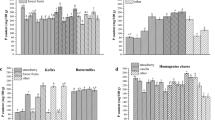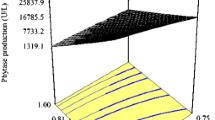Abstract
A modified rapid method for the determination of phytase activity has been developed by measurements of molybdenum blue complex using micro-titer plate reader. This method requires only a small amount of extract, and it is possible to make more replicates at the same time and thus a better sampling and a higher capacity compared to measurements on spectrophotometer, which is traditionally used for those measurements. The extraction time was reduced by 36% compared to standard method and the extinction coefficient for molybdenum blue complex was determined instead of using P-standard solutions. To demonstrate the new method it was applied to the determination of the activity of phytase at a range of pH values and temperatures relevant to the rye bread making process. The activity of rye phytase was 320 nkatal g−1 grains (pH 5.5, 37 °C). The temperature optimum was 45–55 °C and the pH optimum 6.0. The study revealed that the rye phytase is very pH-sensitive and quite stable at different temperatures during the whole bread-making process. The enzyme activity of the endogenous rye phytase is optimal for a total degradation of phytic acid during rye bread making and thus the full bioavailability of phytate-bound minerals.




Similar content being viewed by others
References
Lott JNA, Ockenden I, Raboy V, Batten GD (2002) A global estimation of phytic acid and phosphorus in crop grains, seeds, and fruits. In: Reddy NR, Sathe SK (eds) Food phytates. CRC Press, Boca Raton, pp 7–24
Weaver CM, Kannan S (2002) Phytate and mineral bioavailability. In: Reddy NR, Sathe SK (eds) Food phytates, CRC Press, Boca Raton, pp 211–223
Sandström B, Sandberg A-S (1992) J Trace Elem Electrolytes Health Dis 6:99–103
Haraldsson A-K, Rimsten L, Alminger ML, Andersson R, Andlid T, Åman P, Sandberg A-S (2004) J Sci Food Agric 84:653–662
Casey A, Walsh G (2004) J Biotechnol 110:313–322
Greiner R, Egli I (2003) J Agric Food Chem 51:847–850
Vats P, Banerjee UC (2004) Enzym Microb Technol 35:3–14
Centeno C, Viveros A, Brenes A, Canales R, Lozano A, de la Cuadra C (2001) J Agric Food Chem 49:3208–3215
Pandey A, Szakacs G, Soccol CR, Rodriguez-Leon JA, Soccol VT (2001) Bioresour Technol 77:214
Peers FG (1957) Biochem J 53:102–110
Sandberg A-S, Rossander-Hultén L, Türk M (1996) J Nutr 126:476–480
Wyss M, Brugger R, Kronenberger A, Rémy R, Fimbel R, Oesterhelt G, Lehmann M, van Loon APGM (1999) Appl Environ Microbiol 65:367–373
Andriotis VME, Ross JD (2003) Phytochem 64:689–699
Greiner R, Konietzny U, Jany K-D (1998) J Food Biochem 22:143–161
Okot-Kotber M, Yong K-J, Barorogoza K, Liavoga A (2003) J Cereal Sci 38:307–315
Porres JM, Aranda P, López-Jurado M, Urbano G (2003) J Agric Food Chem 51:5144–5149
Selle PH, Ravindran V, Caldwell RA, Bryden WL (2000) Nutr Res Rev 13:255–278
Nielsen MM, Damstrup ML, Thomsen AD, Rasmussen SK, Hansen Å (2006) Eur Food Res Technol 225:214–222
Stauffer CE (1989) Ester hydrolases. In: Stauffer CE (ed) Enzyme assays for food scientists. AVI BOOK, New York, pp 187–201
Greiner R, Jany K-D, Alminger ML (2000) J Cereal Sci 31:127–139
Skoglund E, Carlsson N-G, Sandberg A-S (1997) J Agric Food Chem 45:4668–4673
Türk M, Sandberg A-S, Carlsson N-G, Andlid T (2000) J Agric Food Chem 48:100–104
Camire AL, Clydesdale FM (1982) J Food Sci 47:575–578
Hatzack F, Hübel F, Zhang W, Hansen PE, Rasmussen SK (2001) Biochem J 354:473–480
Sandberg A-S, Ahderinne R (1986) J Food Sci 51:547–550
Sandberg A-S, Carlsson N-G, Svanberg U (1989) J Food Sci 54:159–161
Türk M, Carlsson N-G, Sandberg A-S (1996) J Cereal Sci 23:257–264
Nakano T, Joh T, Narita K, Hayakawa T (2000) Biosci Biotechnol Biochem 64:995–1003
Phillippy BQ (1989) J Agric Food Chem 37:1261–1265
Eeckhout W, De Paepe M (1994) Anim Feed Sci Technol 47:19–29
Engelen AJ, van der Heeft FC, Randsdorp PHG, Smit ELC (1994) J AOAC Int 77:760–764
Fretzdorff B, Weipert D (1986) Z Lebensm Unters Forsch 182:287–293
Heinonen JK, Lahti RJ (1981) Anal Biochem 113:313–317
Lolas GM, Markakis P (1977) J Food Sci 42:1094–1106
Tipton KF (2002) Principles of enzyme assay and kinetic studies. In: Eisenthal R, Danson MJ (eds) Enzyme assays, Oxford University Press, Oxford, pp 1–48
Bergman E-L, Autio K, Sandberg A-S (2000) J Agric Food Chem 48:4647–4655
Konietzny U, Greiner R, Jany K-D (1995) J Food Biochem 18:165–183
Lee WJ (1990) J Am Soc Brew Chem 48:62–65
Türk M (1999) Cereal- and microbial phytases. phytate degradation, mineral binding and absorption. Dissertation, Chalmers University of Technology
Author information
Authors and Affiliations
Corresponding author
Rights and permissions
About this article
Cite this article
Nielsen, M.M., Damstrup, M.L. & Hansen, Å. An optimised micro-titer plate method for characterisation of endogenous rye phytase under industrial rye bread making conditions. Eur Food Res Technol 227, 1009–1015 (2008). https://doi.org/10.1007/s00217-007-0814-6
Received:
Revised:
Accepted:
Published:
Issue Date:
DOI: https://doi.org/10.1007/s00217-007-0814-6




